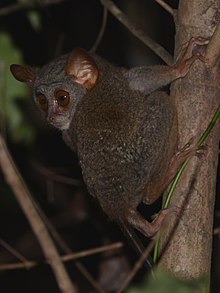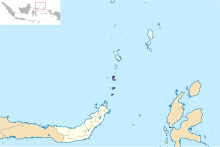Siau Island tarsier
| Siau Island tarsier | |
|---|---|

| |
| Scientific classification | |
| Domain: | Eukaryota |
| Kingdom: | Animalia |
| Phylum: | Chordata |
| Class: | Mammalia |
| Order: | Primates |
| Suborder: | Haplorhini |
| Family: | Tarsiidae |
| Genus: | Tarsius |
| Species: | T. tumpara
|
| Binomial name | |
| Tarsius tumpara | |

| |
The Siau Island tarsier (Tarsius tumpara) is a species of tarsier from the tiny volcanic island of Siau in Indonesia.[2] The T. tumpara species is one of 14 species and 7 subspecies in the tarsier family called "Tarsiidae".[3] They belong to the Haplorrhini suborder, known as the "dry-nosed" primates.[3] The tarsier's eyes are so big that they do not move in its socket and they are almost as big as its brain.[3] Locally in the Siau dialect of Sangir language, the tarsiers are called Tumpara. The name differs from the Sangihe dialect which called tarsiers, Senggasi or Higo, these names are used for the Sangihe tarsier instead.[2]
Characteristics
[edit]Anatomy and physical appearance
[edit]The main characteristics of the tumpara tarsiers include having a white ventral fur, lacking the distinctive golden dorsal fur of the Tarsius sangirensis, and having a larger skull compared to its other relatives. Another way to distinguish the T. tumpara from other tarsier species such as T. sangirensis and T. dianae is its distinctive duet note in the different sexes.[3] The Siau Island tarsier is a very small species which measures around 4 to 6 inches (10–15 cm) in body length.[3] Their long tails can add another 8 inches (20 cm) to their total length.[3] They weigh between 100 and 150 grams, which makes them very quiet when they leap on dense vines or branches.[3]
Eyes
[edit]The Siau Island tarsier has very big eyes that do not move, and have very big irises that range in shades of gold and brown. The size of its eyes helps the species with nocturnal vision. They have foveal vision, which helps them to see things more sharply. However, they lack a tapetum (which is very common in mammals).[3]
Agility
[edit]Siau Island tarsiers are an arboreal species, which means they spend most of their time in trees, and therefore are very agile and excellent at jumping and climbing.[3] They can jump up to 10 ft (3 m) high, have a neck that turns 180 degrees, and have good hearing.[3] They also have long thin fingers which helps them to grab things such as when they are capturing prey.[3] The T. tumpara's main method of hunting consists of sitting quietly on a branch and waiting for a prey to arrive to attack it.[3]
Reproduction
[edit]Siau Island tarsiers can reach sexual maturity at two years old, this means that they carry and give birth to an offspring.[3] Pregnancy lasts around six months and the mother gives birth to a single offspring.[3]
Nutrition
[edit]They are a carnivorous species that feed on small animals such as frogs, lizards and small birds, but mostly eat insects like spiders.[3][4] They have a very wide mouth, strong jaw and sharp teeth which help them feed off small animals.
Geography
[edit]Tarsiers are found in Southeast Asia, though the T. tumpara is endemic to Siau Island, Indonesia.[5] This species was located geographically using GIS and geographic profiling and they have found that they live in a small range of 125 km2 (48 sq mi), with an even smaller occupancy range of approximately 19.4 km2 (7.5 sq mi).[6][7] The tumpara tarsier species has a population of approximately 1,358–12,470 and is declining due to the many threats they face.[4]


Habitat
[edit]The tarsier species are nocturnal and can be found sleeping in tree holes during the day, especially those of fig trees (Ficus), depending on what forest they are in.[6] They can usually be found entering their trees to go sleep between 5:00 AM and 6:00 AM.[6] The members of each group sleep individually in their own trees to avoid a predator attack on the entire family.[3]
Taxonomy
[edit]Its existence as a distinct taxon was predicted by the hybrid biogeographic hypothesis for Sulawesi.[8] The rationale was that a geographic discontinuity existed between the northern tip of Sulawesi, and the population of tarsiers on Sangihe Island (the Sangihe tarsier Tarsius sangirensis), approximately 200 kilometres (120 mi) to the north.[8] In between, lay very deep oceans and three island clusters, Biaro, Tagulandang/Ruang, and Siau. Like Sangihe Island, itself, each of these three island clusters are a part of the Sangihe Island volcanic arc. Volcanic arcs, like the Galapagos and Hawaiian Island chains, feature islands that erupt from the ocean floor. In such circumstances, islands form independently, are colonized independently, and remain geographically isolated. These characteristics lead to high levels of endemism. The presence of tarsiers on the most distant island group in the Sangihe volcanic arc (i.e. Sangihe island), led to curiosity about the presence of tarsiers on the other islands in the chain. Each of the three island clusters mentioned above were surveyed for the presence of tarsiers in 2004 and 2005, but tarsiers were only observed on Siau.

It was furthermore elaborated upon that the original description of T. sangirensis included mention of a specimen from Siau in the Dresden Museum. Thus it was argued for further investigations of the Siau tarsier to see if it was taxonomically separable from T. sangirensis.[9]
Conservation
[edit]The Sangihe Islands are known for their critically endangered avifauna, and concerns about the conservation status of the Siau Island tarsier grew before its formal description.[10] The Siau Island tarsier was selected for the list of "The World's 25 Most Endangered Primates" by the IUCN Species Survival Commission, Primate Specialist Group.[11] Some of the reasons as to why this species of tarsier is critically endangered is because they are hunted for their meat, to be used as traditional medicine and to be sold as domestic pets in the pet trade.[12] Its habit is at risk since it is not recorded as a protected area, and therefore is subjective to drastic habitat loss if no conservation practices are put in place.[13] The progressive disappearance of its habitat, with the large population of the Siau people [311 people/km2], restrains the primate communities within a small area.[7] Other threats such as the volcanic activities of the island, though most of these are interconnected and all play an important role in the endangerment of the tumpara tarsier.[12] This species is rapidly declining, having declined by more than 25% in the last 25 years.[3]
Predators
[edit]The species primary predators are humans, arboreal snakes, lizards, birds of prey and feral cats.[14] However, their cryptic behaviour makes it difficult for predators to catch them.[6]
References
[edit]- ^ Shekelle, M.; Salim, A. (2020). "Tarsius tumpara". IUCN Red List of Threatened Species. 2020: e.T179234A17977202. doi:10.2305/IUCN.UK.2020-3.RLTS.T179234A17977202.en. Retrieved 12 November 2021.
- ^ a b Shekelle, M.; Groves, C.; Merker, S.; Supriatna, J. (2008). "Tarsius tumpara: A new tarsier species from Siau Island, North Sulawesi" (PDF). Primate Conservation. 23: 55–64. doi:10.1896/052.023.0106. S2CID 55493260.
- ^ a b c d e f g h i j k l m n o p q "Siau Island Tarsier | New England Primate Conservancy". 2021-12-16. Retrieved 2022-04-11.
- ^ a b Burton, James A.; Nietsch, Alexandra (2010-12-01). "Geographical Variation in Duet Songs of Sulawesi Tarsiers: Evidence for New Cryptic Species in South and Southeast Sulawesi". International Journal of Primatology. 31 (6): 1123–1146. doi:10.1007/s10764-010-9449-8. ISSN 1573-8604. S2CID 32358378.
- ^ "tarsier | Description, Species, Habitat, & Facts | Britannica". www.britannica.com. Retrieved 2022-04-12.
- ^ a b c d Faulkner, S. C.; Stevenson, M. D.; Verity, R.; Mustari, A. H.; Semple, S.; Tosh, D. G.; Comber, S. C. (2015). "Using Geographic Profiling to Locate Elusive Nocturnal Animals: a Case Study with Spectral Tarsiers". Journal of Zoology. 295 (4): 261–268. doi:10.1111/jzo.12203 – via ZSL.
- ^ a b Shekelle, M.; Groves, C.; Merker, S.; Supriatna, J. (2008). "Tarsius tumpara: A new tarsier species from Siau Island, North Sulawesi" (PDF). Primate Conservation. 23: 55–64. doi:10.1896/052.023.0106. S2CID 55493260.
- ^ a b Shekelle, M.; Leksono, S. M. (2004). "Rencana konservasi di Pulau Sulawesi: dengan menggunakan Tarsius sebagai flagship spesies (Conservation strategy in Sulawesi Island using Tarsius as flagship species)". Biota. 9 (1): 1–10.
- ^ Brandon-Jones, D.; Eudey, A. A.; Geissmann, T.; Groves, C. P.; Melnick, D. J.; Morales, J. C.; Shekelle, M.; Stewart, C. -B. (2004). "Asian primate classification". International Journal of Primatology. 25: 97–164. doi:10.1023/B:IJOP.0000014647.18720.32. S2CID 29045930.
- ^ Shekelle, Myron; Meier, Rudolf; Indrawan, Mochamad; Maryanto, Ibnu; Salim, Agus; Supriatna, Jatna; Andayani, Noviar (2007). "When "Not Extinct" is Not Good News: Conservation in the Sangihe Islands". Conservation Biology. 21 (1): 4–5. Bibcode:2007ConBi..21....4S. doi:10.1111/j.1523-1739.2006.00622_1.x. PMID 17298499. S2CID 31273860.
- ^ Mittermeier, R.A.; Wallis, J.; Rylands, A.B.; Ganzhorn, J.U.; Oates, J.F.; Williamson, E.A.; Palacios, E.; Heymann, E.W.; Kierulff, M.C.M.; Long Yongcheng; Supriatna, J.; Roos, C.; Walker, S.; Cortés-Ortiz, L.; Schwitzer, C., eds. (2009). Primates in Peril: The World's 25 Most Endangered Primates 2008–2010 (PDF). Illustrated by S.D. Nash. Arlington, VA.: IUCN/SSC Primate Specialist Group (PSG), International Primatological Society (IPS), and Conservation International (CI). pp. 1–92. ISBN 978-1-934151-34-1. Archived from the original (PDF) on July 23, 2011.
- ^ a b Macdonald, David W.; Burnham, Dawn; Hinks, Amy E.; Wrangham, Richard (2012). "A Problem Shared Is a Problem Reduced: Seeking Efficiency in the Conservation of Felids and Primates". Folia Primatologica. 83 (3–6): 171–215. doi:10.1159/000342399. ISSN 0015-5713. PMID 23363584. S2CID 8260464.
- ^ Supriatna, Jatna; Winarni, Nurul L.; Dwiyahreni, Asri A. (2015). "Primates of Sulawesi: An Update on Habitat Distribution, Population and Conservation". Taprobanica. 07: 170–192.
- ^ "Tarsier". Wisconsin National Primate Research Center. Retrieved 2022-04-12.
Further reading
[edit]- Shekelle, M.; Salim, A. (2009). "An acute conservation threat to two tarsier species in the Sangihe Island chain, North Sulawesi, Indonesia". Oryx. 43 (3): 419–426. doi:10.1017/S0030605309000337 (inactive 1 November 2024).
{{cite journal}}: CS1 maint: DOI inactive as of November 2024 (link)
External links
[edit]- Siau Island tarsier (Tarsius tumpara) media from ARKive

